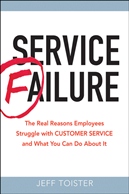Everyone is in charge of customer service
 Jeff Toister
Jeff Toister  Monday, May 10, 2010 at 9:16AM |
Monday, May 10, 2010 at 9:16AM |  I spent last week helping two very different clients improve customer service. One was a boutique hotel that wanted to find ways to improve their already outstanding valet operations. The other was the receiving and mailroom department for a hospital and university that wanted to improve their reputation among university employees. The hotel was an obvious fit for my services, but you could argue that the work I did with the university was even more important. Serving their customers at a high level could literally mean delivering surgical supplies just in time to save a patient's life or tracking down some mis-delivered samples that a researcher ultimately uses to find a new cure for cancer.
I spent last week helping two very different clients improve customer service. One was a boutique hotel that wanted to find ways to improve their already outstanding valet operations. The other was the receiving and mailroom department for a hospital and university that wanted to improve their reputation among university employees. The hotel was an obvious fit for my services, but you could argue that the work I did with the university was even more important. Serving their customers at a high level could literally mean delivering surgical supplies just in time to save a patient's life or tracking down some mis-delivered samples that a researcher ultimately uses to find a new cure for cancer.
High performing organizations make customer service a part of everyone's job. It's easy to imagine the importance of customer service in settings where someone has frequent, service-oriented contact with customers. The best companies realize that everyone has an impact on customer service, even when their connection to customers is less obvious.
The classic restaurant example
When we dine out we most frequently evaluate the restaurant's service based on our interactions with our server. Were they friendly? Did they get our order right? Was our drink refilled? Let's look at who else has an impact:
-
The host or hostess seats you in a timely manner and makes sure there is someone covering that section who can serve you. There's a lot of logistics and teamwork required to make this happen!
-
The dishwasher ensures your dishes and utensils are clean. You only notice this person's work if they don't do their job.
-
The buser makes sure you have a clean table with the appropriate place-settings, keeps your water refilled, and quickly removes your dirty plates.
-
The cook makes sure your food is correctly prepared and comes out as delicious as it sounds on the menu. You rarely see your cook, but you will definitely see their work!
-
The manager makes sure everyone is working together in concert.
Good service will result if all of the above people do their job. All it takes is one person to drop the ball for a guest to have a poor experience.
Less obvious examples
I've provided customer service training for a lot of unusual groups over the years. One thing they all have in common is service makes their job easier and creates better results for the people they serve. Here are some examples of the types of people I've trained:
Accounts Receivable. This group used service techniques to speed up payments from clients while preserving client relationships when bills were past due.
Housing Assistant. A public agency that provided rental assistance to low-income families used customer service techniques to serve their clients more efficiently and improve productivity.
Loan Underwriting. An underwriting department improved their service to loan officers, which resulted in faster decisions and better client retention when loans were not approved.
Sales. Sales representatives leveraged customer service techniques to grow sales with existing clients and differentiate themselves with new prospects.
Plumbers. A plumbing company used customer service to stand out from competitors by making sure they did more than fix leaks. They ensured home owners could easily recommend their service.
Customer service training isn't the solution for every situation, but customer service should be everyone's priority. Feel free to contact us for a complimentary brain-storming session if you'd like to get some ideas on how to get everyone in your organization focused on service.






